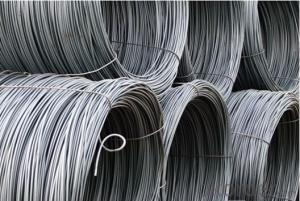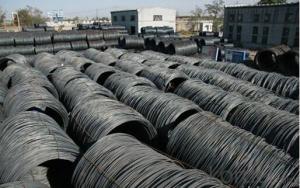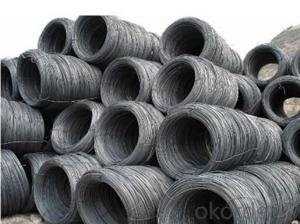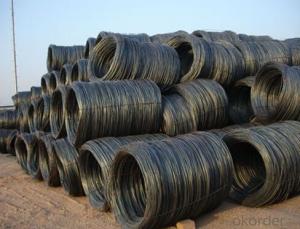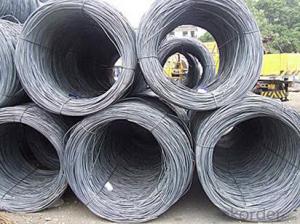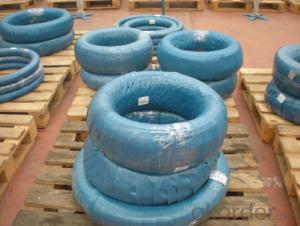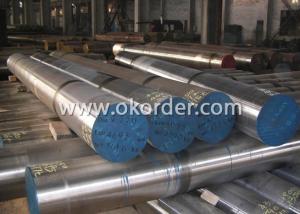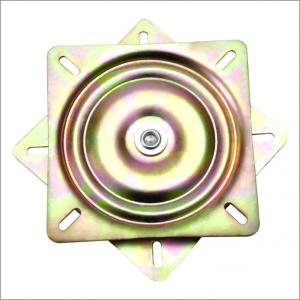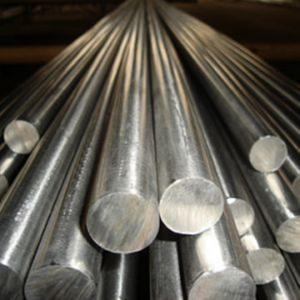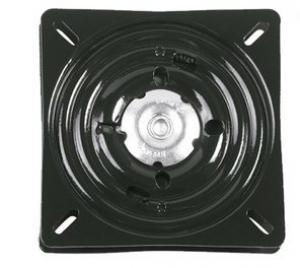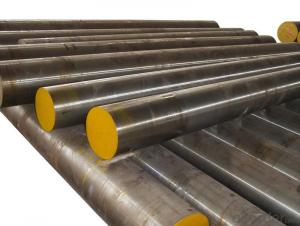m.s Wire Rod in Coils SAE1006/1008/1010/1012
- Loading Port:
- Tianjin
- Payment Terms:
- TT OR LC
- Min Order Qty:
- 10 m.t.
- Supply Capability:
- 10000 m.t./month
OKorder Service Pledge
OKorder Financial Service
You Might Also Like
Item specifice
m.s Wire Rod in Coils SAE1006/1008/1010/1012
Details of the m.s Wire Rod in Coils SAE1006/1008/1010/1012
| Steel Grade | Q195-Q235,Q235,SAE 1008-1018 Hot Rolled Steel Wire Rod |
| Diameter | 5.5, 6.5, 7,8, 9,10, 12,14mm.etc. |
| Coil weight | 2m.t. |
| Application | drawing, construction materials, machinery parts,construction for Houses, Bridges, Roads,Packing |
| Deliver Time | 25-30 days after receipt of L/C or deposit by T/T |
| Packing | In coils, loading in container or by bulk vessel |
| Payment terms | 1).100% irrevocable L/C at sight. |
| 2).30% T/T prepaid and the balance against the copy of B/L. | |
| 3).30% T/T prepaid and the balance against L/C |
| Chemical Composition(%) | ||||||
| C | Mn | Si | S | P | Cr | |
| SAE1006B | 0.03~O.07 | ≤0.32 | ≤0.30 | ≤0.045 | ≤0.040 | 0.3-0.35 |
| Mechanical properties | ||||||
| Yield strength(N/mm2) | Tensile strength(N/mm2) | Elongation(%) | ||||
| 250-280 | 350-380 | ≥32 | ||||
| Grade | Chemical Composition(%) | |||||
| C | Mn | Si | S | P | Cr | |
| SAE1008B | 0.10max | 0.3~O.50 | 0.15max | 0.050max | 0.040 max | 0.3-0.35 |
| Mechanical properties | ||||||
| Yield strength(N/mm2) | Tensile strength(N/mm2) | Elongation(%) | ||||
| ≥195 | 315-430 | ≥30 | ||||
Supplier of the m.s Wire Rod in Coils SAE1006/1008/1010/1012
CNBM International Corporation is the most import and export platform of CNBM group(China National Building Material Group Corporation) ,which is a state-owned enterprise, ranked in 270th of Fortune Global 500 in 2015.
With its advantages, CNBM International are mainly concentrate on Cement, Glass, Iron and Steel, Ceramics industries and devotes herself for supplying high quality series of refractories as well as technical consultancies and logistics solution.
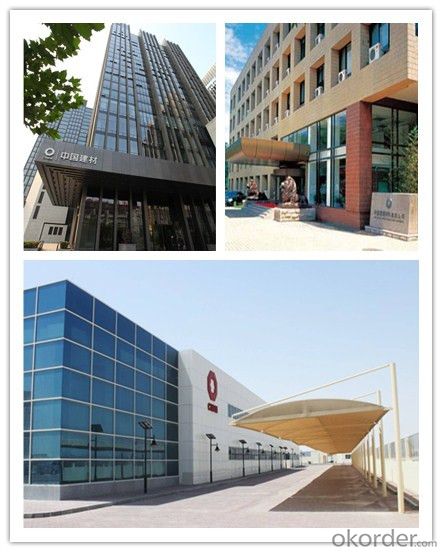
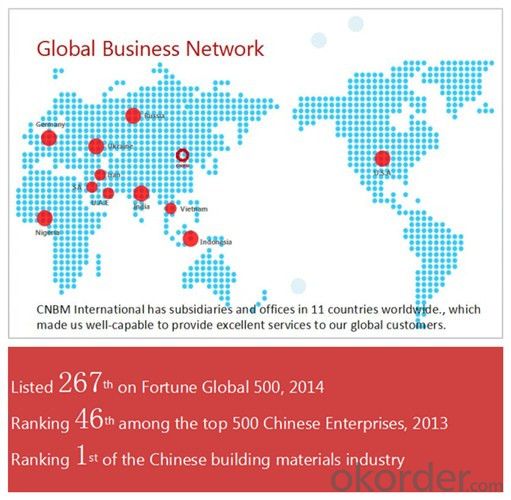
Delivery of the m.s Wire Rod in Coils SAE1006/1008/1010/1012
Packaging Detail | Sea worthy packing /as per customer's packing instruction |
Delivery Detail | 15 ~ 40 days after receiving the deposit |
Products Show
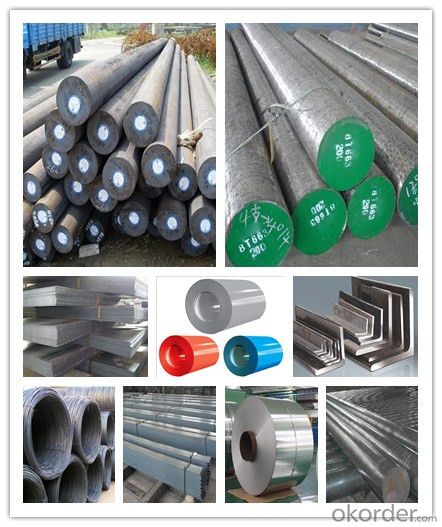
FAQ:
Are you a trading company or manufacturer? | Manufacturer |
What’s the MOQ? | 3 metric ton |
What’s your delivery time? | 15-35 days after downpayment received |
Do you Accept OEM service? | Yes |
what’s your delivery terms? | FOB/CFR/CIF |
What's the Payment Terms? | 30% as deposit,70% before shipment by T/T |
Western Union acceptable for small amount. | |
L/C acceptable for large amount. | |
Scrow ,Paybal,Alipay are also ok | |
Why choose us? | Chose happens because of quality, then price, We can give you both. Additionally, we can also offer professional products inquiry, products knowledge train (for agents), smooth goods delivery, excellent customer solution proposals. |
What's your available port of Shipment? | Main Port, China |
What’s your featured services? | Our service formula: good quality+ good price+ good service=customer's trust
|
Where are your Market? | Covering more than 160 countries in the world |
- Q:What is the cost of special steel compared to regular steel?
- The cost of special steel is generally higher compared to regular steel due to its unique properties, composition, and production processes.
- Q:How does special steel contribute to the longevity of products?
- There are several ways in which special steel contributes to the longevity of products. To begin with, its exceptional strength and durability are well-known. Special steel is specifically designed to endure extreme conditions, such as high temperatures, pressure, and corrosive environments. This makes it highly suitable for use in various industries, including aerospace, automotive, and construction. The remarkable strength of special steel enables products to bear heavy loads and resist deformation, ensuring they remain intact and functional for a prolonged period of time. For example, in the construction industry, special steel is frequently employed in structural components like beams and columns, which provide crucial support and stability to buildings over many years. Furthermore, special steel possesses excellent resistance to wear and abrasion. It can endure constant friction, impact, and contact with other materials without significant deterioration. This characteristic is vital in industries where products are subjected to continuous use, such as machinery, tools, and equipment. The utilization of special steel in these applications guarantees that the products remain in good working condition for an extended period, reducing the need for frequent repairs or replacements. Additionally, special steel exhibits exceptional resistance to corrosion, making it highly resistant to rust and other forms of corrosion. This property is especially advantageous in products exposed to harsh environments or chemicals, like marine vessels, pipelines, and chemical processing equipment. Through the utilization of special steel, manufacturers can significantly prolong the lifespan of these products, minimizing the risk of failure or breakdown due to corrosion. In conclusion, special steel contributes to the longevity of products through its provision of superior strength, durability, wear resistance, and corrosion resistance. Its extraordinary properties enable products to withstand harsh conditions, heavy loads, and continuous use, guaranteeing that they remain functional and reliable for an extended period. By incorporating special steel into their designs, manufacturers can greatly enhance the lifespan of their products, leading to cost savings, improved reliability, and customer satisfaction.
- Q:What are the environmental considerations of using special steel?
- There are several environmental considerations associated with the use of special steel. Firstly, the production of special steel involves the extraction and processing of raw materials, which can have significant environmental impacts. The mining of iron ore and other minerals required for steel production often results in habitat destruction, soil erosion, and water pollution. Additionally, the energy-intensive processes used to convert raw materials into steel emit large amounts of greenhouse gases, contributing to climate change. Furthermore, the disposal of special steel products at the end of their life cycle can also pose environmental challenges. Steel is a non-renewable resource, and its disposal in landfills can contribute to waste accumulation and resource depletion. However, steel is highly recyclable, and recycling steel products can significantly reduce the environmental impact associated with their disposal. In terms of transportation, special steel is often heavy and bulky, which leads to higher fuel consumption during transportation. This can contribute to air pollution and carbon emissions, particularly if long-distance shipping is involved. Moreover, the manufacturing processes used to produce special steel can generate various types of waste, such as slag and dust, which need to be properly managed to prevent negative environmental impacts. The treatment and disposal of these waste materials require careful consideration to ensure they do not contaminate soil, water, or air. To mitigate these environmental considerations, companies in the steel industry have been adopting more sustainable practices. This includes investing in cleaner technologies, such as electric arc furnaces that use recycled steel as feedstock, to reduce energy consumption and emissions. Additionally, implementing efficient waste management systems and promoting steel recycling can help minimize waste generation and resource depletion. Overall, while the use of special steel has undeniable benefits in various industries, it is crucial to consider and address the associated environmental impacts. Adopting sustainable practices throughout the entire lifecycle of special steel, from raw material extraction to end-of-life disposal, is vital in minimizing its environmental footprint and promoting a more sustainable future.
- Q:Can special steel be used in the production of gearboxes?
- Yes, special steel can be used in the production of gearboxes. Special steel, such as alloy steel or tool steel, offers higher strength, durability, and wear resistance, making it suitable for use in gearboxes that require heavy-duty performance and efficient power transmission.
- Q:What are the factors that can affect the machinability of special steel?
- There are several factors that can affect the machinability of special steel. One of the main factors is the composition of the steel. The presence of certain elements such as carbon, chromium, and nickel can greatly influence the machinability. For example, high carbon content can result in increased hardness and brittleness, making the steel more difficult to machine. On the other hand, the addition of elements like sulfur and lead can improve machinability by enhancing chip formation and reducing friction. The heat treatment of the steel also plays a significant role in machinability. Different heat treatments, such as annealing or quenching, can alter the microstructure of the steel, affecting its hardness and toughness. Heat-treated steels may be more difficult to machine due to their increased hardness or the presence of residual stresses. The mechanical properties of special steel, such as hardness and tensile strength, can also impact machinability. Harder steels require more cutting force and may result in increased tool wear or vibration during machining. Similarly, steels with high tensile strength may pose challenges in terms of chip formation and tool life. The cutting conditions and machining parameters used also affect machinability. Factors such as cutting speed, feed rate, and depth of cut can significantly impact the process. High cutting speeds can result in increased temperatures and tool wear, while low cutting speeds may lead to poor surface finish. Additionally, the choice of cutting tools, their geometry, and their coatings can also influence the machinability of special steel. Finally, the presence of impurities or contaminants in the steel, such as non-metallic inclusions or surface defects, can negatively affect machinability. These impurities can cause tool wear, poor surface finish, or even tool breakage. Therefore, the quality and cleanliness of the steel are crucial for achieving good machinability. In summary, the factors that can affect the machinability of special steel include its composition, heat treatment, mechanical properties, cutting conditions, and the presence of impurities. Understanding and optimizing these factors can help improve the machinability and overall performance of special steel during machining operations.
- Q:What are the different casting methods used for special steel?
- There are several different casting methods used for special steel, including sand casting, investment casting, continuous casting, and centrifugal casting. Each method has its own advantages and is suited for specific applications. Sand casting is a common and cost-effective method that involves pouring molten steel into a sand mold. Investment casting, on the other hand, uses a wax pattern that is coated in a ceramic shell and then melted away to leave a cavity for the steel to be poured into. Continuous casting is a continuous process where molten steel is poured into a water-cooled mold and solidifies into a continuous strand. Finally, centrifugal casting involves spinning a mold while pouring the molten steel, creating a centrifugal force that helps distribute the metal evenly. These different methods allow for the production of special steel components with various sizes, shapes, and properties.
- Q:What are the non-destructive testing methods used for special steel?
- There are several non-destructive testing (NDT) methods that are commonly used for special steel. These methods are designed to detect flaws or defects in the steel without causing any damage to the material. One of the most widely used NDT methods for special steel is ultrasonic testing. This technique involves sending high-frequency sound waves through the steel and analyzing the echoes that are reflected back. By measuring the time it takes for the sound waves to travel through the steel and return, technicians can determine the thickness, density, and internal structure of the material. Ultrasonic testing is particularly effective at detecting cracks, voids, or inclusions in the steel. Another commonly used NDT method for special steel is magnetic particle testing. This technique involves applying a magnetic field to the surface of the steel and then coating it with a magnetic powder. Any defects or irregularities in the steel will create magnetic flux leakage, causing the magnetic particles to cluster and form visible indications. This method is particularly effective at detecting surface cracks or discontinuities in the steel. Liquid penetrant testing is another NDT method that is often used for special steel. This technique involves applying a liquid dye or fluorescent material to the surface of the steel. The dye penetrates any surface cracks or defects, and after a specified dwell time, excess dye is removed. A developer is then applied, which draws out the dye from any flaws, making them visible under UV light. This method is effective at detecting surface discontinuities and is commonly used in the aerospace and automotive industries. Radiographic testing is another NDT method that can be used for special steel. This technique involves exposing the steel to X-rays or gamma rays and capturing the resulting image on a film or digital detector. By analyzing the radiographic image, technicians can detect internal flaws such as cracks, voids, or inclusions in the steel. This method is particularly useful for thicker sections of steel or when access to the material is limited. In conclusion, non-destructive testing methods such as ultrasonic testing, magnetic particle testing, liquid penetrant testing, and radiographic testing are commonly used for special steel. These methods allow for the detection of flaws or defects in the steel without causing any damage to the material, ensuring its integrity and reliability.
- Q:How does special steel perform in cryogenic applications?
- Special steel is renowned for its exceptional performance in cryogenic applications, characterized by extremely low temperatures that fall below -150 degrees Celsius (-238 degrees Fahrenheit). Unlike regular steel, which tends to become brittle and weaker in such conditions, special steel, also referred to as cryogenic steel or low-temperature steel, is specifically engineered to withstand these extreme cold temperatures. One of the key advantages of special steel lies in its ability to maintain its mechanical properties even at cryogenic temperatures. It retains its strength, toughness, and ductility, enabling it to endure the stresses and strains imposed on it in cryogenic environments. As a result, special steel finds application in various fields, including aerospace, energy, and healthcare, where it is used in cryogenic storage tanks, pipelines, and equipment. Another significant feature of special steel is its excellent resistance to brittle fracture at low temperatures. This is of utmost importance since brittle fractures occur when materials become excessively brittle and fail under stress. The distinct composition and processing methods employed in special steel help prevent such fractures, ensuring the integrity and safety of components within cryogenic systems. Furthermore, special steel possesses a low coefficient of thermal expansion, meaning it undergoes minimal dimensional changes when exposed to temperature fluctuations. This characteristic proves highly advantageous in cryogenic applications as it preserves the stability and reliability of equipment and structures. Additionally, special steel exhibits commendable corrosion resistance, which is vital in cryogenic environments where the presence of moisture and certain chemicals can accelerate corrosion processes. By resisting corrosion, special steel enhances the longevity and durability of components, thereby reducing maintenance and replacement costs. In conclusion, special steel is the preferred choice for cryogenic applications due to its ability to maintain mechanical properties, resist brittle fracture, display low thermal expansion, and exhibit corrosion resistance. These properties render it a dependable and efficient material for use in cryogenic systems, providing the necessary strength and durability even under extremely low-temperature conditions.
- Q:What are the challenges in manufacturing special steel?
- There are several challenges in manufacturing special steel. One of the main challenges is ensuring the precise composition and properties of the steel. Special steels often require specific alloying elements and precise heat treatments to achieve desired characteristics, making it crucial to maintain strict quality control throughout the manufacturing process. Another challenge is the high cost of raw materials and the need for advanced equipment and technology to produce special steel. Additionally, meeting stringent industry standards and regulations, as well as managing environmental impacts, can pose challenges in the manufacturing of special steel.
- Q:What are the main alloying elements in special steel?
- The main alloying elements in special steel can vary depending on the specific type or grade of steel. However, some common alloying elements found in special steel include chromium, nickel, molybdenum, vanadium, tungsten, and cobalt. These alloying elements are added to steel to enhance its properties such as corrosion resistance, strength, hardness, and heat resistance. Each alloying element has its own unique effect on the steel, allowing for the creation of specialized steel grades for various applications in industries such as aerospace, automotive, oil and gas, and construction.
1. Manufacturer Overview |
|
|---|---|
| Location | |
| Year Established | |
| Annual Output Value | |
| Main Markets | |
| Company Certifications | |
2. Manufacturer Certificates |
|
|---|---|
| a) Certification Name | |
| Range | |
| Reference | |
| Validity Period | |
3. Manufacturer Capability |
|
|---|---|
| a)Trade Capacity | |
| Nearest Port | |
| Export Percentage | |
| No.of Employees in Trade Department | |
| Language Spoken: | |
| b)Factory Information | |
| Factory Size: | |
| No. of Production Lines | |
| Contract Manufacturing | |
| Product Price Range | |
Send your message to us
m.s Wire Rod in Coils SAE1006/1008/1010/1012
- Loading Port:
- Tianjin
- Payment Terms:
- TT OR LC
- Min Order Qty:
- 10 m.t.
- Supply Capability:
- 10000 m.t./month
OKorder Service Pledge
OKorder Financial Service
Similar products
New products
Hot products
Related keywords
